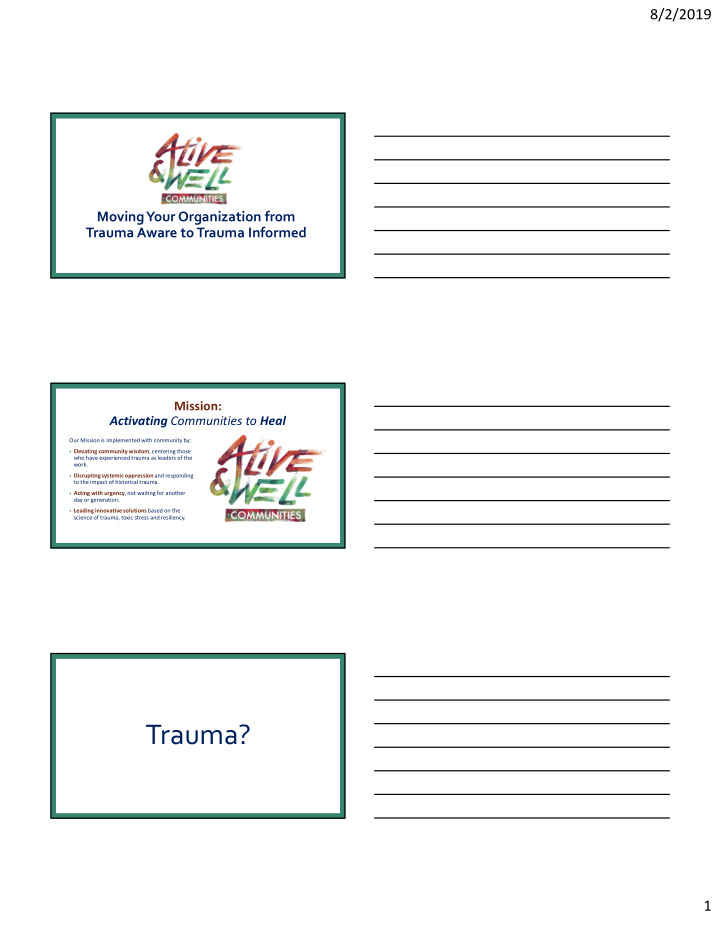



8/2/2019 Moving Your Organization from Trauma Aware to Trauma Informed Mission: Activating Communities to Heal Our Mission is implemented with community by: • Elevating community wisdom , centering those who have experienced trauma as leaders of the work. • Disrupting systemic oppression and responding to the impact of historical trauma. • Acting with urgency , not waiting for another day or generation. • Leading innovative solutions based on the science of trauma, toxic stress and resiliency. Trauma? 1
8/2/2019 Understanding Trauma E vent – Actual experience or threat of physical or psychological harm OR the lack/withholding/control of material or relational resources crucial to health and development. Can be a single event or repeated events. E xperience – How someone assigns meaning to the event, which depends on the perception of the individual. E ffects – Results of the person’s experience of the event. This can include neurological, physical, emotional, and cognitive effects . + Working definition – SAMHSA, Trauma and Justice Private Event Trauma Characterized by: • Secrecy • Power imbalance • Sense of hopelessness • Sense of isolation • Sense of irretrievable loss Public Event Trauma Characterized by: • Shared experience • Lack of judgment • Sense of helplessness • Forces beyond control • Sense of irretrievable loss 2
8/2/2019 Community Trauma Characterized by: • A combination of experiences that negatively impact a community • An event that impacts a few people but has structural and social consequences Stress-Response System When we are faced with Fight stressful situations , our Flight mind and body automatically respond Freeze in one of three ways: Chronic Trauma Multiple traumatic Multiple instances Environmental or events happening or of the same or community to the same person traumatic event trauma Chronic Trauma , regardless of the type, has a cumulative effect-impacting the brain, body, and all areas of functioning. 3
8/2/2019 Prevalence of Trauma More than 50% of the general population have experienced at least one traumatic event . What is the prevalence of trauma in your community? Prevalence of Trauma • As adults, children who were placed in foster care have PTSD rates TWICE as high as US War Veterans. ( Northwest Foster Care Alumni Study, Pecora, et al., 2005 ) • Nearly 40% of adolescents have directly witnessed an act of violence. ( Flannery, D., and Huff, C.R. Youth violence: Prevention, intervention, and social policy. Washington, DC: American Psychiatric Press, 1998) • Despite the importance of epidemiologic information, obtaining precise estimates of the prevalence and incidence of different types of potentially traumatic events that can occur in childhood is actually problematic. ( Saunders, B. E., & Adams, Z. W. (2014). Epidemiology of Traumatic Experiences in Childhood. Child and Adolescent Psychiatric Clinics of North America , 23 (2), 167–184.) Adverse Childhood Experiences (ACEs) Source: Liverpool CAMHS 4
8/2/2019 Impact of Trauma First published in 1998, the Adverse Childhood Experience Study showed that: • Traumatic experiences are vastly more common than recognized or acknowledged • There is a powerful relationship between emotional experiences as children and physical and mental health as adults, including diabetes, heart disease and some types of cancer , as well as depression, alcoholism and drug abuse Impact of Trauma Impact of Trauma & 5
8/2/2019 Impact of Trauma Impact of Trauma 6
8/2/2019 Impact of Trauma on the Brain Trauma can impact the developing brain by… • Reducing the number of connections formed • Reducing the size of the cortex • Strengthening survival connections Resulting in … • Memory problems • Attention difficulty • Language development delays • Emotional and behavioral regulation issues Impact of Trauma on the Brain • When the stress response is activated, the release of cortisol can lead to the creation of flashbulb memories of events associated with intense emotional reactions, both positive and negative. • Triggers are formed that allow for intense physiological recall of these powerful memories. Impact on the Body If an individual’s body is responding to acute stress for a prolonged period, whether a child or adult, the increased adrenaline and other hormones can cause increased blood sugars , heart rates and changes in blood flow along with other often harmful biological responses . 7
8/2/2019 Activating Hyper-arousal Event “Acting Out” Window of Tolerance Normal Range Hypo-arousal Elaine Miller-Karas & L. “Shutting Down” Leitch(c)2007 Key Concepts of TRM Becoming Trauma-Informed A program, organization, or system that is trauma-informed: 1. Realizes the widespread impact of trauma and understands potential paths for recovery; 2. Recognizes the signs and symptoms of trauma in clients, families, staff and others involved with the system; 3. Responds by fully integrating knowledge about trauma into policies, procedures and practices; 4. And seeks to actively resist re-traumatization. -Substance Abuse and Mental Health Services Administration The Core Principles 8
8/2/2019 Intervention • Many effective therapeutic interventions are available for individuals of all ages through various individual or group modalities. • Trauma is not “cured” – therapeutic intervention is unable to erase the traumatic event(s) and individuals may require additional intervention at various points throughout the lifespan . • You don’t have to be a therapist to be therapeutic . One buffering, supportive individual can mitigate the trajectory of trauma. Responding to People with Trauma We must : • Acknowledge that we may unintentionally trigger someone’s trauma response . • Work to see an individual’s responses and behaviors as the result of changes in the brain and body . • Strive to see the world through the lens of trauma. Changing the Question To become alive and well, we need to change the question from… What’s wrong with you? to What happened to you? 9
8/2/2019 www.awcommunities.org 10
Recommend
More recommend